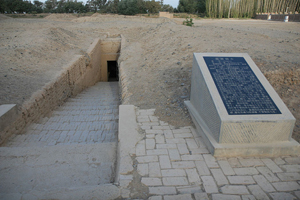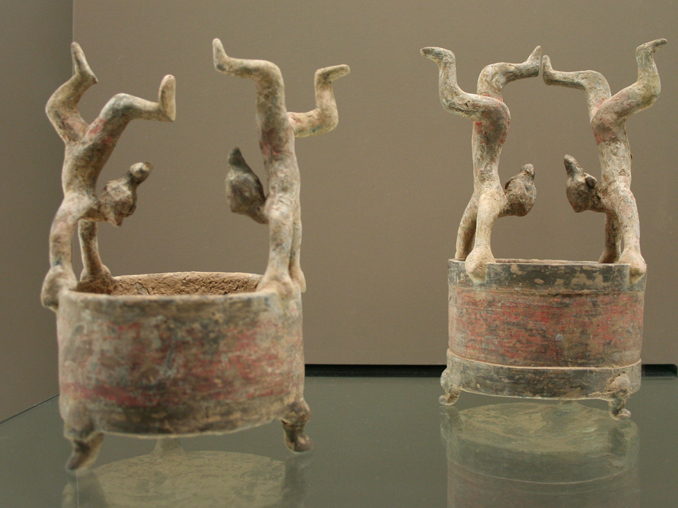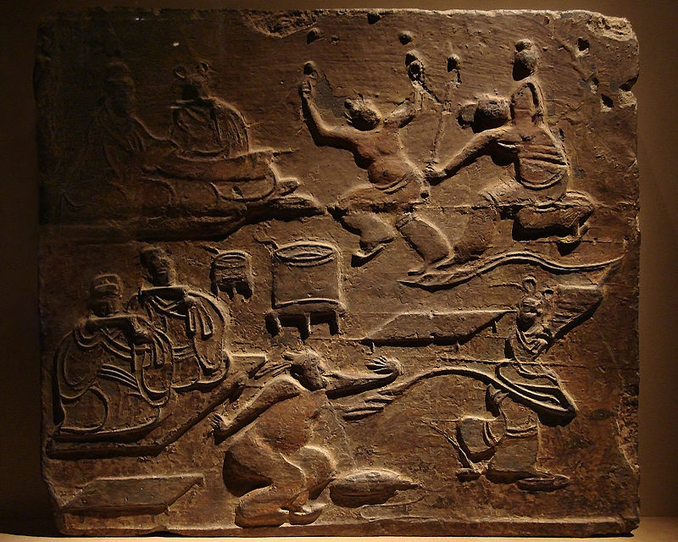Written by: Wu Yanchun
Posted on: October 18, 2014 | 
Astana ancient underground tombs in Turpan
In last century, a group of acrobatic figures was unearthed from the Astana Ancient Tombs in Turpan, Xinjiang, which greatly impressed the local people and specialists since it made apparent that there existed excellent acrobats in the ancient Western Regions of China.
 |
Entrance to the Astana tombs |
Those figures, including Headstand Figure, Somersault Figure, and Hundred-Trick Figures, etc. seem almost real. The term ‘Hundred-Trick (bai ji) was found as early as 202BC – 220AD in the Han Dynasty with quite rich acts including wresting, hand skills, balancing on forehead, climbing poles, martial arts, tightrope, etc. Normally, the performance would be accompanied with music and dances on big stages. As recorded in the Music Volume, Sui Book of Sui Dynasty (581-618 AD), ‘(they were) played with strange and spectacular skills, and often went for more than hundred rounds, hence was called Hundred-trick’. However, in the time of Tang Dynasty (618-907 AD) the performance took another name: Loose Music (san yue). In Tong Dian (book about general rules and regulations), it is mentioned that ‘Generally, San Yue was composed of tricks and magic mainly, and had all come from the Western Regions’, which manifested that acrobatics and magic, etc. were all introduced to the inland from the Western Regions. And the discovery of acrobatic figures in Astana served as evidence for the prevalence of acrobatics in Turpan area during Tang period.
The two Tang Dynasty wooden figures unearthed from Astana reassert the fact that playing “Balancing with Poles” and headstand together was popular at the time. The pole holder stood firmly on the ground with both feet apart, head erect, shoulders down and the back straight. Both of the hands stretch out to keep balance, while the pole stands on its head steadily. And there is a kid upside down on the top of the pole. With only left hand supporting it, the figure of the little one stretches out both of its feet to the sky and keep its head up to make eye contact with audience. The pose on the whole combines both flying gesture and static solidarity, displaying excellent balancing and coordination of movements and strength between the holder and the kid, showcasing great capacity of human body skills.
 |
Acrobat figurines from Western Han era |
One of documents of Jin Dynasty (265-420 AD) gives a vivid narration about a kid playing on the top of pole. “What a wonderful play! He climbs up and down along the standing pole, swiftly and skillfully in changing postures. Once his both feet serve as hook hanging the body upside down, then he returns to his feet again, like a tiny dragon coiling round…” Similar records in Sui Dynasty also told a story about the Loose Music performance, it said: “There are two men, one holds the pole, while the other dances on the pole, making flying movements”. As for the secret of the two acrobatics; it was in the neck for the pole holder and waist of the dancer. As revealed by a poem of Tang, “The supporter has extremely strong power in his neck and the dancer on the pole certainly puts most of his strength on the waist for every move”.
Among the antique figures from Turpan, there is a kid playing tumbling. He supports himself only with his right hand on the ground, doing a somersault. This posture is described as ‘dancing with the feet directed towards the sky and head to the earth’. Usually, the play is accompanied with other performances as well. As recorded in one historical archive, once there was a Brahman who came to the Emperor and offered to perform his tricks with music. Following the rhythm, the dancer walked backwards, but on his way there were blades, so he had to walk through these blades with care and grace. Or in other cases the knives were planted on the ground with tips pointing to the sky, and the acrobats had to make handsprings among or over the forest of knives, sometimes even with the music player sitting on his belly, which all required unbelievable skills.
 |
Pictorial brick depicting acrobats from the Eastern Han dynasty |
Excellent acrobatic art of the ancient Western Region was developed after being inspired by the capacity and potential of the human body. It aroused great attention and appreciation among the local and inland Chinese people after being introduced to the inland areas. As a result, people wrote poems and stories about them and also made pictographic art works on them for permanent memory.
You may also like: